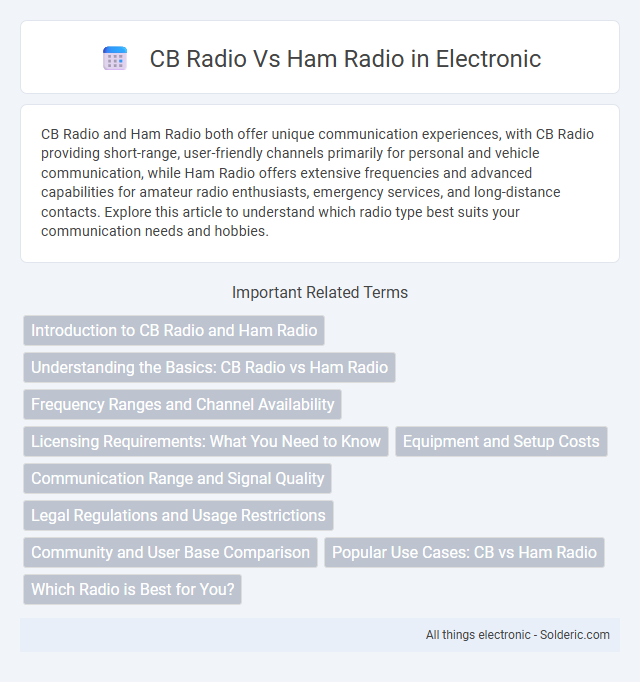CB Radio and Ham Radio both offer unique communication experiences, with CB Radio providing short-range, user-friendly channels primarily for personal and vehicle communication, while Ham Radio offers extensive frequencies and advanced capabilities for amateur radio enthusiasts, emergency services, and long-distance contacts. Explore this article to understand which radio type best suits your communication needs and hobbies.
Comparison Table
| Feature | CB Radio | Ham Radio |
|---|---|---|
| Frequency Range | 26.965 to 27.405 MHz (40 channels) | Multiple bands from 1.8 MHz to 300 GHz |
| License Requirement | No license needed | License required (Technician, General, Amateur Extra) |
| Transmission Power | 4 watts AM, 12 watts SSB max | Up to 1500 watts (depending on license) |
| Communication Range | Short range (1-20 miles typical) | Long range (local to global) |
| Primary Use | Personal, vehicle communication | Emergency communication, experimentation, hobby |
| Modulation Types | AM and SSB | AM, FM, SSB, CW, digital modes |
| Equipment Cost | Low ($50-$150) | Variable ($100-$2000+) |
| Community | Smaller, local user base | Large, global community |
Introduction to CB Radio and Ham Radio
CB Radio operates on 40 channels within the 27 MHz band, primarily used for short-distance personal and business communication without requiring a license. Ham Radio, or amateur radio, spans multiple frequency bands from HF to UHF, enabling long-distance communication, emergency services, and hobbyist experimentation, requiring an operator license. Both radios serve distinct purposes, with CB Radio favoring ease of use and Ham Radio offering extensive technical capabilities and global connectivity.
Understanding the Basics: CB Radio vs Ham Radio
CB Radio operates on 40 channels within the 27 MHz band and is primarily designed for short-distance, one-way communication, making it ideal for personal or vehicular use. Ham Radio, or amateur radio, covers a wider range of frequencies from HF to UHF and enables two-way communication, emergency signaling, and international contacts, requiring an FCC license to operate. Your choice depends on whether you seek casual, hassle-free communication with minimal setup (CB Radio) or advanced, versatile communication capabilities with technical involvement (Ham Radio).
Frequency Ranges and Channel Availability
CB Radio operates on 40 channels within the 27 MHz (11-meter) band, providing limited frequency options primarily for short-range communication. Ham Radio spans a vast range of frequencies across multiple bands from MF, HF, VHF, to UHF, offering thousands of channels tailored for various communication modes and distances. Understanding these frequency ranges helps you choose the right radio system based on your communication needs and regulatory restrictions.
Licensing Requirements: What You Need to Know
CB Radio operates without a license, allowing users to communicate instantly on designated channels with minimal setup, making it ideal for casual, short-range use. Ham Radio requires an FCC-issued license, which involves passing a written exam to ensure knowledge of radio regulations and technical skills, granting access to a broader range of frequencies and higher power limits. Understanding these licensing requirements helps you choose the right radio system based on your communication needs and legal obligations.
Equipment and Setup Costs
CB radio equipment typically costs between $50 and $200, with minimal setup requirements, making it ideal for casual communication. Ham radio equipment varies widely, from entry-level transceivers around $200 to advanced setups costing several thousand dollars, requiring licenses and technical knowledge. Your choice depends on budget and willingness to invest time in setup and licensing.
Communication Range and Signal Quality
CB Radio typically operates within a range of 1 to 15 miles, depending on terrain and atmospheric conditions, making it suitable for short-distance communications. Ham Radio offers a significantly broader communication range, often spanning hundreds to thousands of miles through the use of various frequency bands, including HF, VHF, and UHF, resulting in superior signal quality and reliability. Your choice between CB and Ham Radio will depend on whether you prioritize local communication or long-distance connectivity with clearer and more stable transmissions.
Legal Regulations and Usage Restrictions
CB Radio operates under the FCC Part 95 rules, allowing unlicensed use on 40 channels with a maximum power of 4 watts for AM and 12 watts for SSB. Ham Radio requires an FCC license and adherence to strict regulations governing operating frequencies, power limits, and communication protocols across multiple bands. CB Radio is primarily for short-distance personal communication, while Ham Radio supports broader, often international, communication and emergency services under tighter legal oversight.
Community and User Base Comparison
CB Radio boasts a large, diverse community primarily consisting of truck drivers, off-road enthusiasts, and casual users, facilitating easy and informal communication over short distances. In contrast, Ham Radio attracts a dedicated, technically skilled user base passionate about long-distance communication, emergency services, and experimentation with radio technology. Your choice depends on whether you seek a broad, accessible community or a specialized group with advanced radio knowledge and capabilities.
Popular Use Cases: CB vs Ham Radio
CB radio is primarily used for short-distance communication among truck drivers, off-road enthusiasts, and local community groups due to its simplicity and license-free operation. Ham radio offers a broader range of use cases, including emergency communication, long-distance contact via multiple frequency bands, and participation in amateur radio contests, supported by its extensive technical capabilities and licensing requirements. The versatility of ham radio makes it popular among hobbyists and professionals who require reliable, worldwide communication.
Which Radio is Best for You?
Choosing between CB radio and ham radio depends on your communication needs and technical expertise. CB radio offers simplicity and ease of use for short-distance, legal-limit communication without a license, ideal for casual conversations and road travel. Ham radio demands more knowledge and licensing but provides greater range, emergency communication capabilities, and access to a global network, making it best for hobbyists and serious communicators seeking advanced features.
CB Radio vs Ham Radio Infographic

 solderic.com
solderic.com